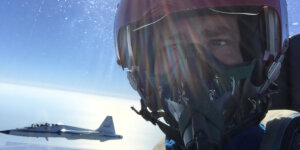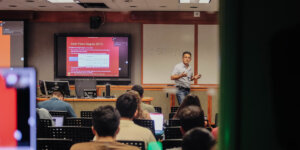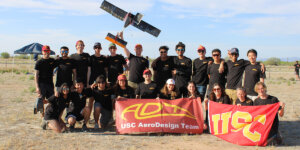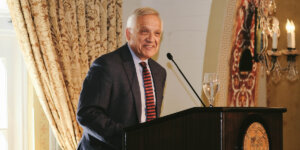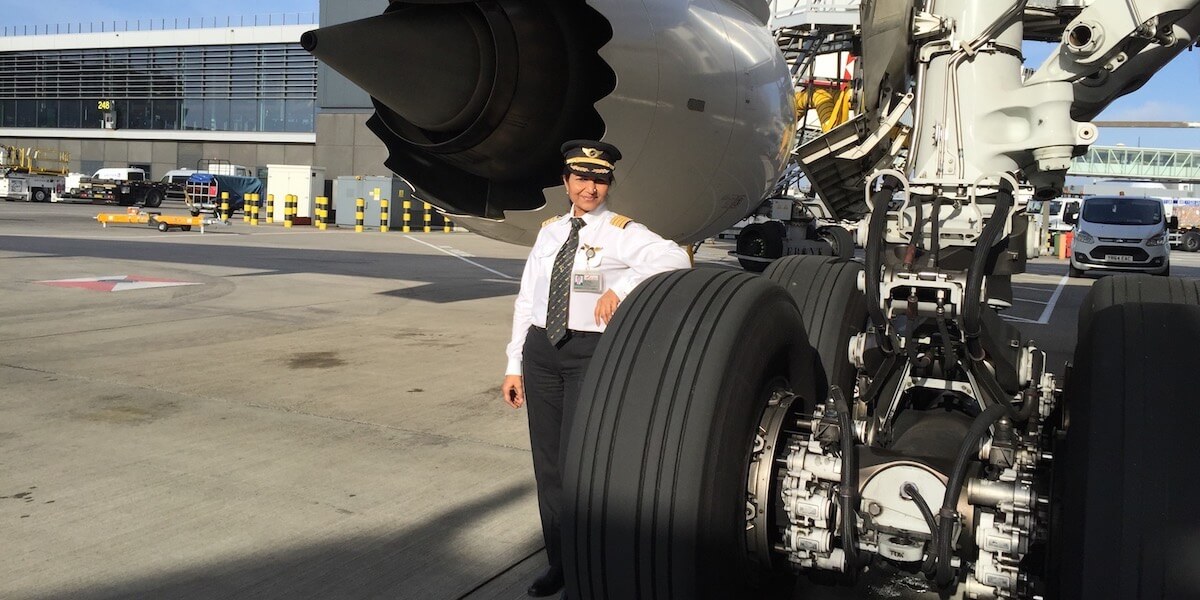
Captain Nivedita Bhasin (Photo/Courtesy of Nivedita Bhasin)
The flight from New Delhi to Singapore started uneventfully enough.
After about an hour and a half in the air, though, Air India Captain Nivedita Bhasin noticed smoke intermittently wafting through the air vents of the Dreamliner Boeing B787. The pungent smoke quickly thickened, requiring Bhasin to don an oxygen mask and immediately come up with a plan of action.
A highly decorated pilot with more than 22,000 flight hours, Bhasin calmly told passengers she planned to divert the plane to Calcutta, reassuring them that everything would be OK. She then went through a trouble-shooting checklist to identify the problem, which turned out to be a melted part caused by a leak in an air conditioning duct, something that could have possibly sparked an onboard fire.
Bhasin’s confidence and composure never wavered during the entire 25 minutes it took to safely land the increasingly smoke-filled plane. Only in retrospect does she acknowledge just how badly it all could have ended.
“You know, flying is hours of boredom and seconds of terror,” said Bhasin, who in 1989 became the youngest woman pilot in world civil aviation history to command a commercial jet aircraft at age 26. Just five years earlier, she had become the third woman pilot at Indian Airlines, which, in 2007, merged with Air India.
“We are trained for every kind of eventuality. But when something happens, it’s not the simplest of situations,” added Bhasin, a recent certificate recipient from the famed USC Aviation Safety and Security Program. “You have to make split second decisions. You have to keep your focus.”
Her unflappable disposition, analytical mind and intellect, combined with a distinguished four-decade, barrier-shattering career, led Air India to appoint Bhasin as chief of flight safety in February, a position she will held until her mandatory retirement in late July at 58. In becoming the first female pilot to serve as the airline’s chief of safety, Bhasin enhances and maintains a high safety standard and oversees Air India’s response to any emergency incidents or accidents, especially those involving its 120-plane fleet.
“It’s a 24/7 job,” Bhasin said with a laugh.
A sterling career
From giving friends rides in a glider to piloting the massive Boeing 787 Dreamliner and every other type of plane in Air India’s fleet, Bhasin has consistently shined during her 37-year airline career.
In 1985, she served as co-pilot of the first all-women crew, a flight from Calcutta to Silchar on a 44-seat Fokker Friendship F27 turboprop jet. “We got a lot of media attention for that,” she said.
Four years later, in 1989, then 26-year-old Bhasin became the world’s youngest female commercial airline captain, when she received command of a Boeing 737.
More recently, in 2011, Bhasin participated in a dangerous mission rescuing Indian nationals trapped in Libya during that country’s civil war. Chaos reigned at Tripoli International Airport, forcing Bhasin to sometimes wait on the tarmac for hours as passengers slowly made their way to the aircraft.
Recently, Air India named her executive director and safety chief, a position she will also hold until July 31.
For her many contributions to aviation, Bhasin has won several national and international awards, including the coveted Rajiv Gandhi Rashtriya Ekta Award.
Bhasin credits her success to what she calls the “three Ds: determination, dedication and discipline. This will carry you through your life no matter what you want to do.”
And so it has.
Free as a bird
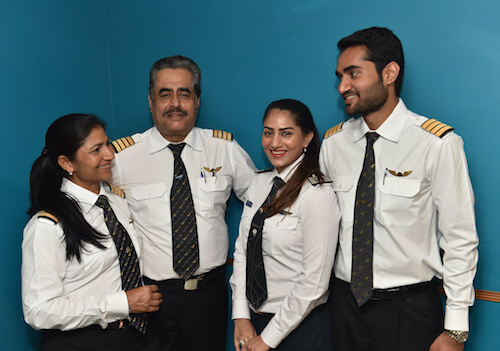
Every member of Nivedita Bhasin’s immediate family is a pilot: (Left to right) Nivedita Bhasin; Husband Rohit Bhasin; Daughter Niharika Bhasin; and son Rohan Bhasin. (Photo/Courtesy of Nivedita Bhasin)
As a little girl, Bhasin looked longingly into the sky. She saw freedom.
“I was always, always watching the airplanes, watching the birds flying,” she said. “I just wanted to be up there from as long as I can remember.”
By 12, Bhasin knew she wanted to become a pilot and fly the world’s biggest planes. That India had nearly no female pilots at the time mattered not a whit to her. She had her parents’ support, a dream and “a single-minded devotion to something I wanted to achieve,” she said. “I knew if I put my mind to it, I could do it.”
Three years later, Bhasin began building and flying model airplanes, so-called aeromodelling. At 16, she joined the local gliding club. Bhasin learned how to gracefully bring an engineless plane back to earth from an altitude of about 1,000 feet – often with friends along for the ride. More important, her gliding instructor shared some hard-won wisdom that Bhasin heeds to this day: “He told me, ‘Overconfidence is a pilot’s worst enemy and deadly.’”
By the time she had graduated from high school, Bhasin had taken flying lessons and made a solo flight on a Pushpak aircraft. She seemed to have everything it took to become a successfully pilot – except the money.
India’s flying academies are quite expensive. After Bhasin’s father left a high-paying executive marketing job to become an entrepreneur, her family struggled financially. Unless she could somehow land a government grant or scholarship, Bhasin knew her dream of taking to the skies would flame out.
A beloved uncle heard of her predicament and decided to act. Unbeknownst to Bhasin, he applied for government funding on her behalf at a flight academy in Patna, a city far away from her home in New Delhi. Happily, Bhasin landed the coveted scholarship.
Unhappily, she would soon have her first encounter with persistent sexism that only worsened over the years.
“They were waiting for you to do something wrong”
Of the 50 students at Bhasin’s new flight school, 47 were men. When two of the women quit, that left her as the only one.
It wasn’t easy. Many of Bhasin’s classmates tagged her as an outsider who had taken a scholarship away from a more deserving local candidate. Worse, she was a woman.
“Boys would make passing remarks whenever I walked by. It was a really tough time for me,” Bhasin said. “But my dream was to fly, and I wasn’t going to let anything stop me.”
Bhasin studied harder and flew more than almost any of her classmates. She earned her pilot’s license before she turned 19, and Indian Airlines hired her a year later in 1984. At the time, the airline had only three women pilots: one hired in 1966, another in 1980, and Bhasin.
In her early years, Bhasin often felt isolated and alone, with several male colleagues subjecting her to a barrage of sexist and hostile comments. Captains mockingly asked who did the cooking at home or told her she could never have children and pursue such a demanding career at the same time. Some asked her out. When she rebuffed their advances, the men became implacably hostile.
“All the time you would feel that people were looking at you, they were waiting for you to do something wrong, to make a mistake, basically to prove that this career wasn’t meant for women,” said Bhasin, adding that early on even some passengers had misgivings about flying with a female pilot.
As she had done at flight school, Bhasin tuned out the steady stream of sexism. Instead, she focused on being the best pilot possible.
In addition to becoming the world’s youngest female pilot to command a jet just five years into the career, Bhasin later achieved another milestone. in 1997, she reached her personal goal of piloting the then-largest plane in Indian Airlines’ fleet, an Airbus A300. Bhasin subsequently captained the Airbus A300, the Airbus A330 and the Dreamliner, later serving as a trainer on all of them.
Along the way, the frosty reception Bhasin received from some male captains and co-pilots gave way to a grudging respect and then full acceptance. Even passengers began to welcome the sight of Bhasin, resplendent in her pilot’s uniform, seated in the cockpit.
Perhaps the fact that so many Indian women have followed the path that Bhasin helped blaze contributed to the shift in attitudes. Today, the country has the highest percentage of women in the air at 12.4%, compared to just 5.4% for the United States, according to Statista. Whatever the reason, Bhasin said she started to feel more comfortable as a woman pilot in a largely male-dominated field. Whereas she once rarely laughed or joked with her male coworkers, lest they characterize her as frivolous, Bhasin said she has become more herself on the job over the decades. Still, Bhasin quickly added, nothing distracts her from the mission of ensuring a safe, smooth flight.
Bhasin, who once kept as low a profile as possible, said she now embraces her position as a role model to legions of Indian girls and women who dream of taking to the skies.
“What we’ve received in life, I think we have to share it with the next generation of women, to pay it forward,” Bhasin said. “We have to tell them that it’s a very tough life and what we’ve been through, but that it’s been worth every minute of it.”
One of the women Bhasin inspired is her own daughter, Niharika Bhasin, who now flies as A320 Captain for IndiGo, as does her husband, Rohit. Her son, Rohan Bhasin, is a Boeing B777 Captain for Air India. Nivedita Bhasin’s father-in-law, the late Jaidev Bhasin, was among the first seven pilots in the country to become a commander in 1954 – making flying a truly family affair.
“I don’t think there’s anybody else in India where the husband and wife and all the children are airline captains,” Nivedita Bhasin said with pride.
Landing in Troy
When the pandemic hit, the number of Air India flights, like those at other airlines, plummeted. By May 2020, Bhasin flew an average of only once a month. For the first time in her long career, she had a bit of time on her hands.
Never one to waste a minute or an opportunity, Bhasin decided to take an online course at the USC Aviation Safety and Security Program — part of the USC Viterbi School of Engineering — the gold standard of aviation safety management education. For nearly 70 years, the program, the first of its type at a major university, has taught pilots from major U.S. and international airlines, civil aviation authorities and accident investigators from Nigeria, Singapore, Denmark and Mexico, among dozens of other countries, how to prevent aircraft hazards, crashes and emergencies.
Bhasin signed up with USC’s program because she had heard about the quality of its faculty and curriculum. Still, she expected to take only one course. That’s because New Delhi is 13 hours ahead of L.A.; Bhasin had no desire to be on Zoom in the middle of the night for hours on end.
Then Thomas Anthony became her mentor and instructor. The director of the USC Aviation Safety and Security Program and a former investigator for the Federal Aviation Administration, Anthony taught aviation safety and management systems, engaging Bhasin and her classmates with his knowledge, ability to spark group discussion and use of lots of concrete examples to explain complex ideas.
Bhasin had such a good experience that she took another course, human factors in aviation safety, and then another, safety management for remotely piloted aircraft, and then another, aircraft accident investigation.
“I literally fell in love with the USC program,” said Bhasin, who earned a her Aviation Safety and Security Certificate in April.
Anthony said he learned as much from her as she did from him.
“She was able to learn and read and absorb the material in such a way that she benefited not just the rest of the class and herself but me as her instructor by virtue of her insight, comments and questions,” he said.
For Bhasin, her courses were more than simply an academic exercise. She said they helped her pass a rigorous oral exam to become Air India’s chief of safety and gave her an invaluable education to do her job better. “If I had not done these courses, it would have been a herculean task for me to have slipped into my current role,” Bhasin said.
After giving up her positions as Air India’s chief of safety and executive director when she retires, Bhasin isn’t exactly sure what she plans to do next. However, Bhasin said she plans to advocate for the widespread adoption among India’s airlines of sustainable aviation fuel, a hybrid that includes biofuels, used cotton clothing and “other waste material,” in her words.
“I’m not slowing down at all,” Bhasin said.
One thing she’s certain of, though, is how proud she feels having earned her certificate, joining her younger brother, Archit Jain, a 1999 graduate of the USC School of Architecture, as a proud member of the Trojan Family.
“We now have two USC grads in the family,” Bhasin said.
Published on July 15th, 2021
Last updated on September 29th, 2022





